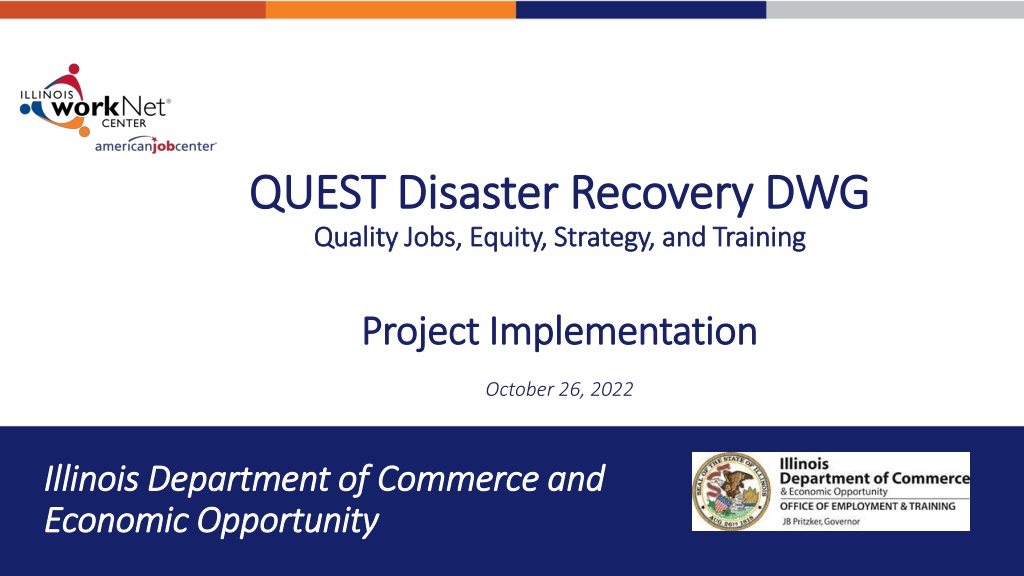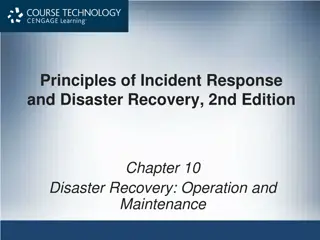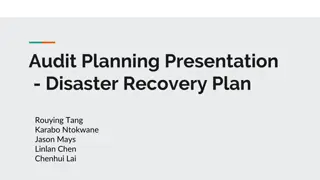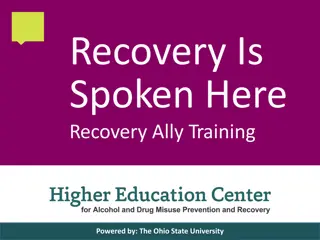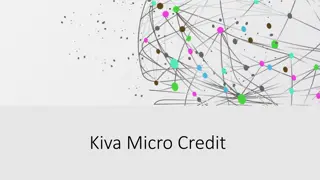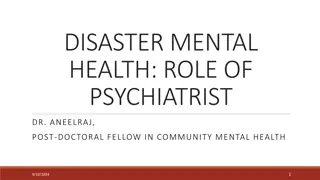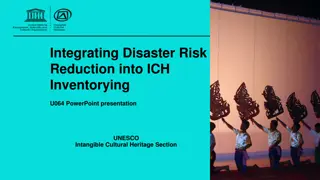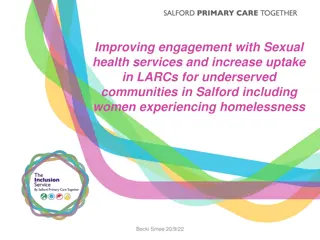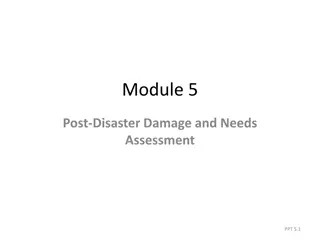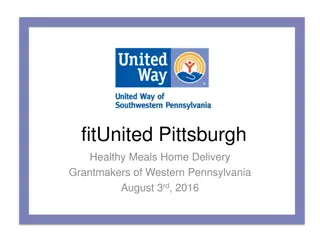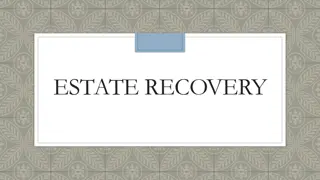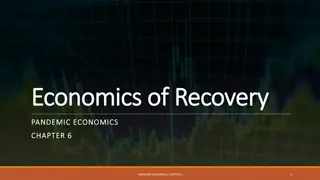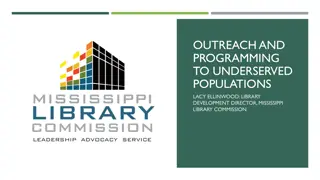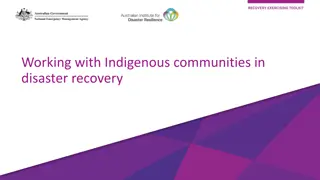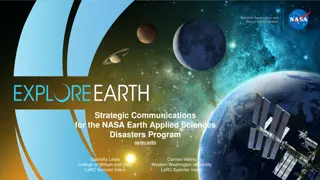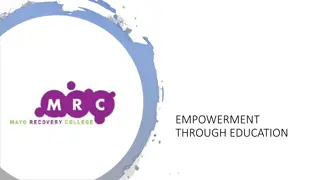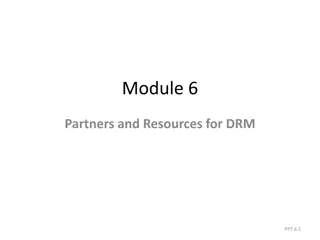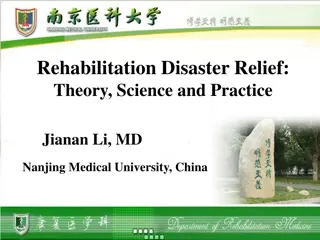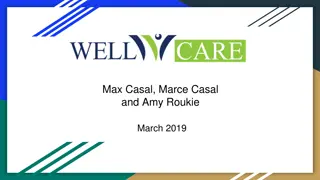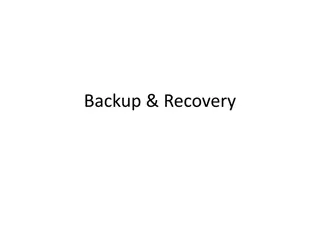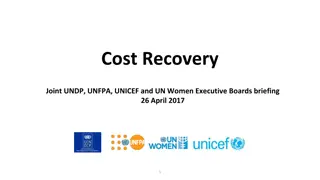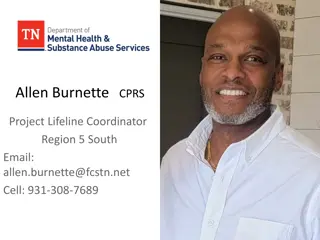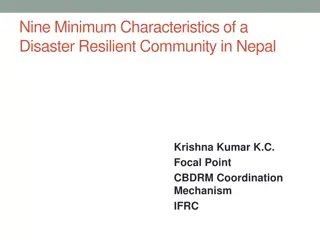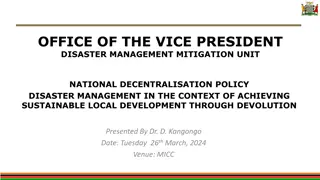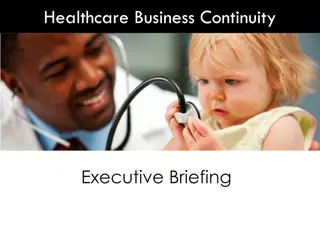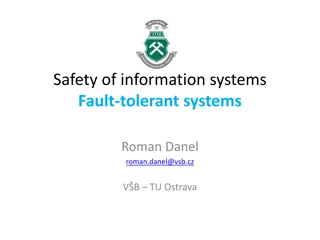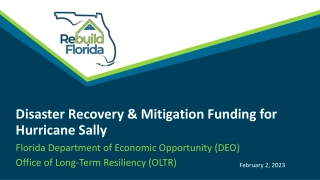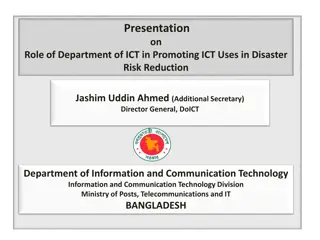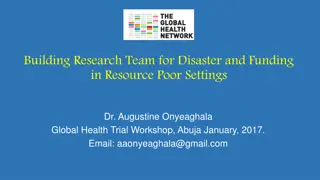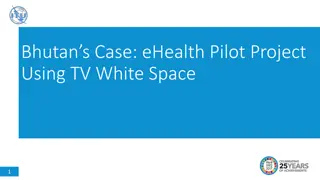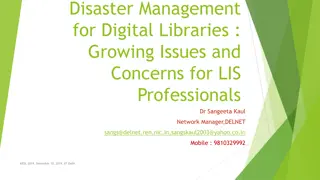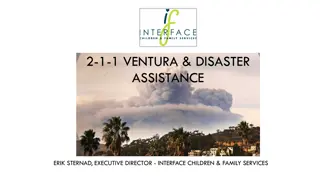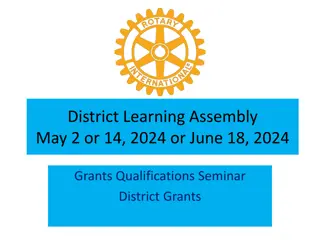Empowering Underserved Communities through Disaster Recovery Project Implementation
Focusing on disaster recovery, this project led by the Illinois Department of Commerce and Economic Opportunity aims to provide quality jobs, equity, strategy, and training to individuals from historically marginalized groups. The initiative includes grant information, employment and training services, and emphasizes reaching underserved populations through targeted outreach and strategic partnerships. Key areas of focus involve enhancing equity, fostering strong business engagement, and creating high-quality job opportunities, with a particular emphasis on serving those affected by the COVID-19 pandemic.
Download Presentation

Please find below an Image/Link to download the presentation.
The content on the website is provided AS IS for your information and personal use only. It may not be sold, licensed, or shared on other websites without obtaining consent from the author. Download presentation by click this link. If you encounter any issues during the download, it is possible that the publisher has removed the file from their server.
E N D
Presentation Transcript
QUEST Disaster Recovery DWG QUEST Disaster Recovery DWG Quality Jobs, Equity, Strategy, and Training Quality Jobs, Equity, Strategy, and Training Project Implementation Project Implementation October 26, 2022 Illinois Department of Commerce and Illinois Department of Commerce and Economic Opportunity Economic Opportunity
Agenda Agenda QUEST Disaster Recovery DWG Grant Information Project Requirements Overview Employment & Training Services and other Grant Activities Disaster Relief Employment (optional component) Grant Modifications; Fiscal Project Management & Oversight; Project Reporting Performance Public Communications: Public-Facing Documents Disclosure Jim Potts: Serving QUEST Disaster DWG Clients; IWDS Resources Q and A -- Please submit questions in the chat pod 2
QUEST Disaster DWG Grant Information QUEST Disaster DWG Grant Information Review Grant Agreement, Exhibit A/Project Description for detailed project requirements. Participating LWIAs: 1, 3, 7, 13, 19, 20, 21, 25 IDES will be conducting a project evaluation; details currently being developed Grant Period: October 1, 2022 to September 30, 2024 Grant Number Series: 22-671xxx; Select 22-671xxx QUEST Disaster Recovery DWG from the drop-down menu when enrolling clients. Disaster/Emergency: COVID-19 pandemic Participants: Serving Disaster Recovery eligible individuals from underserved and historically marginalized groups or communities Services: Comprehensive employment & training services; optional Disaster Relief Employment (can modify grant to add this component) Also: creating targeted participant outreach strategies, developing and maintaining strategic/targeted partnerships, and implementing strong business engagement activities DREs (IWDS code #99A) are not a Work Experience because the primary purpose is to provide labor to assist the community with the disaster; learning/training is a secondary benefit that benefits the worker. DREs are Disaster Recovery Services level of service not a Career Service level activity. Must follow local policies (e.g. Supportive Services/Needs-Related Payments, ITAs, Work-Based Training, etc.) 3
Project Areas of Emphasis Project Areas of Emphasis DOL is emphasizing the following project areas which you ll periodically be reporting on (see DOL QUEST DWG Terminology attachment): How specifically (including new or expanded strategies) are you reaching the target populations of underserved and historically marginalized communities/groups. Provide participant demographic information to show who is being served We will be collecting participant numbers of those in Qualified Census Tracts/Disproportionately Impacted Areas. Participant address lookup: locations of disproportionately impacted areas or qualified census tracts may be obtained by searching the address at the following link: https://www.illinoisworknet.com/qctdiamap Practices to increase equity Strong business engagement activities and results High-quality jobs Disaster Relief Employment work being performed 4
QUEST DWG Project Goals QUEST DWG Project Goals Enable individuals who have been adversely affected by the COVID-19 pandemic and the social and economic inequities that the pandemic exacerbated, to enter, return to, or advance in high-quality jobs. QUEST DWG funds will enhance the public workforce system s ongoing efforts to empower America s unemployed and underemployed workers through worker and business engagement, elevate equity, and connect jobseekers with high- quality jobs. The QUEST DWG program is to be aligned with existing state and local strategic priorities, resources, and programs and not operated as a stand-alone project. The Grantee is to design and carry out the QUEST DWG project to operate in alignment with other state and local programs, including Rapid Response, layoff aversion, other DWG grant awards, and the formula Dislocated Worker program, and to focus on returning dislocated workers and other eligible individuals to sustainable, quality, family-supporting employment. 5
Eligible Participants Eligible Participants Individuals eligible to receive services through the QUEST DWG grant are underserved and historically marginalized individuals from one of the following Disaster Recovery DWG eligibility categories: 1. A dislocated worker; 2. A long-term unemployed individual as defined by the Grantor; 3. An individual temporarily or permanently laid off as a consequence of the COVID-19 pandemic disaster; 4. A self-employed individual who became unemployed or significantly underemployed as a result of the COVID-19 pandemic disaster. NOTE: If a person is eligible as a Dislocated Worker and also one of the other three eligibility categories, they are to be certified eligible as a Dislocated Worker. 6
Disaster Eligibility: Long Disaster Eligibility: Long- -Term Unemployed Term Unemployed A long-term unemployed individual, defined by the State as an individual who: 1.) has no work history; has not worked for an extended period of at least six weeks; or has an intermittent, erratic, or day-to-day employment work history (e.g., multiple terminations, employment gaps, temporary/seasonal/day labor employment, justice-touched history, etc.); 2.) has an employment barrier (as defined by the State or the local Board) and is unemployed; or 3.) is underemployed, including working or needing to work multiple jobs or earning less than $15/hour; 7
Disaster Eligibility: Laid Off Due to COVID Disaster Eligibility: Laid Off Due to COVID- -19 19 An individual temporarily or permanently laid off as a consequence of the disaster or emergency (e.g., flood, tornado, fire, COVID-19, etc.), including individuals who were fired or voluntarily left their job (quit, resigned) due to the disaster or emergency; Examples of leaving a job due to the COVID-19 disaster/emergency include, but are not limited to, individuals who: contracted or were exposed to COVID and stayed home to quarantine/isolate or to care for a COVID-impacted individual or a child schooling at home; were in an at-risk health category; lacked access to adequate daycare; no longer felt safe in their job/career, in their work environment, or during their work commute due to COVID; experienced a change in work hours or shifts due to reduced schedule of business operations; complied with CDC/State/local COVID requirements (e.g., required vaccinations; quarantine/isolation; testing; masking; etc.). 8
Disaster Eligibility: Self Disaster Eligibility: Self- -Employed Employed A self-employed individual who became unemployed or significantly underemployed as a result of the emergency or disaster, including significantly underemployed individuals who experienced a substantial change in the need or demand for, or the ability to deliver their product or service; were unable to find or retain adequate staffing, suppliers, or vendors resulting in significant impact to operations; or experienced a substantial change in their costs or pricing because of the disaster/emergency. 9
Employment & Training Services Employment & Training Services Comprehensive Employment and Training Services will be provided consistent with local policies; QUEST project is operated similar to 1D. Career Services Training Services Supportive Services, including Needs-Related Payments Follow-up 10
IWDS Case Notes: Eligibility and Services IWDS Case Notes: Eligibility and Services Thorough case notes for DWG participants are required. Initial case notes must explain the circumstances as to why/how the person is eligible as a dislocated worker or one of the other 3 eligibility categories, and also explain/describe how the participant meets the underserved or historically marginalized requirement. Do not use a cut and paste generic description. The case note is to be descriptive in explaining an individual s personal circumstances. Case notes must tell the story of the client in terms of their eligibility for the grant and also service determination (including assessment, suitability, etc.) and delivery of services, including periodic review and update, as appropriate, of a participant s IEP and their supportive services needs. 11
Project Activities: Project Activities: Targeted Participant Outreach Targeted Participant Outreach Create and execute a focused outreach campaign designed to reach the target population of underserved and historically marginalized individuals and communities and those who were most adversely affected by the COVID-19 pandemic so that potentially eligible participants are aware of and are able to enroll in grant-funded activities. 12
Project Activities: Project Activities: Strategic Partnerships Strategic Partnerships Develop and maintain strategic partnerships with community organizations and other entities to develop targeted efforts aimed at identifying and enrolling eligible participants from underserved and historically marginalized communities and groups, and develop and maintain partnerships with employers and employer groups to assist the targeted group with skill development and training, work-based training and permanent employment opportunities. 13
Project Activities: Project Activities: Business Engagement Activities Business Engagement Activities Implement strong business engagement activities to work closely with businesses to not only assist with finding the workers they seek, but to also share information in the value and business benefits of increasing job quality and equity, and support in creating or expanding high-quality jobs including both strategic and operational activities, and incorporating as appropriate the Illinois Workforce and Innovation Board s (IWIB) Business Engagement Committee recommendations and guidance related to business engagement strategies. 14
Disaster Relief Employment Component Disaster Relief Employment Component DRE is an optional project component. If DRE is not currently part of your Project Plan, you may add DRE to your project after discussions with DCEO and submitting DRE documents and a grant modification request. DRE jobs respond to/address the ongoing health, employment, and social impacts of the COVID-19 pandemic. DRE jobs address humanitarian needs (e.g., food and shelter) in the community and provide disaster recovery assistance (e.g., contact tracing, vaccination assistance, COVID mitigation). DRE jobs are limited to 12 months or 2,080 hours, whichever is longer. DRE jobs must adhere to the wage, employment duration, and other requirements defined in TEGL No. 16-21 and all other applicable USDOL and Grantor guidance. Must submit to DCEO for prior review and approval the following DRE documents: DRE Worksite Summaries, DRE Worksite Agreements, and DRE job descriptions. 15
DRE: Job Descriptions DRE: Job Descriptions For each DRE job description, identify exactly how the position is impacting COVID in the community, describing job tasks as COVID-related. It must be clear to LWIA staff, participants, Disaster-Relief Employer, worksite supervisor, and Monitors (local and State) why each position is necessary what are the expected outcomes and benefits related to fighting COVID? What happens if the job isn t performed? Each job must have a Job Description written for the COVID work to be performed, clearly indicating the outcomes and benefits of performing the work in terms of impacting COVID; cannot be a generic Job Description for the position. The Job Description will be part of the Worksite Agreement, Participant Orientation, Supervisor Orientation, and Monitoring. If the DRE work being performed transitions/evolves into work not impacting COVID then the DRE work is to be ended. 16
DRE: Disaster DRE: Disaster- -Relief Employer Relief Employer Disaster-Relief Employer. Disaster-Relief Employers are entities designated by a Grantee or their subgrantee(s) to carry out day-to-day human resources and payroll activities of DRE. Grantee must have a Worksite Agreement with Disaster-Relief Employers to ensure that they comply with all Disaster Recovery DWG and other relevant rules and requirements, including with regard to employment activities, participant eligibility, participant safety and health (including OSHA safety and work condition standards), pay and benefits, unemployment insurance, workers compensation, and state requirements. Costs charged to the QUEST DWG grant by a Disaster-Relief Employer must comply with the limitations in the WIOA statute and regulations (including DWG regulations at 20 CFR Part 687) and TEGL No. 16-21. Grantee must ensure that Disaster-Relief Employer negotiations, pricing and any fees contained in the contract and charged to the grant are reasonable and fair and that any competition is full and open, and consistent with local procurement policy. 17
DRE: Participant Wages DRE: Participant Wages DRE Participant Wages. Disaster Relief Employment participants must receive wages that are at minimum the higher of the federal, State, or local minimum wage. In accordance with WIOA Section 181(a)(1)(A), generally, participants must be compensated at the same rates, including periodic increases, shift differential, benefits, or overtime pay, as employees who are similarly situated in similar occupations by the same employer and who have similar training, experience, and skills. Such rates must be in accordance with applicable law but in no event less than the higher of the rate specified in Section 6(a)(1) of the Fair Labor Standards Act of 1938 (29 U.S.C. 206(a)(1)) or the applicable state or local minimum wage law. Where applicable, fringe benefits should be paid in accordance with the benefits that the Disaster-Relief Employer offers its own employees working a similar length of time and doing the same type of work. However, in cases where the Disaster-Relief Employer does not have other employees doing the same or similar work and with similar training, experience, and skills, Grantee must ensure that the wages that they pay to participants: 1. are in line with the industry standard for that type of work in the area where the work is to be performed, supported by documentation; and, 2. are at least $15 per hour. These additional wage requirements are beneficial to both workers and communities affected by the disaster, as they will ensure that disaster relief employment funds are being used to accelerate the financial recovery of unemployed and underemployed participants. They may also lead to faster hiring and project startup, enabling Grantees to more quickly deploy Disaster Recovery DWG funds to mitigate the effects of disasters. 18
DRE: Health and Safety Standards DRE: Health and Safety Standards DRE Health and Safety Standards. Disaster Recovery DWG participants are afforded the same health and safety standards established under Federal and state law applicable to working conditions of permanent employees. To the extent that state workers compensation law applies, Disaster-Relief Employers must provide workers compensation to project participants on the same basis as individuals in similar employment, as required by WIOA Section 181(b)(4). In cases in which a project participant is not covered under a state workers compensation law, based on the status of the Disaster-Relief Employer with whom they are placed, the temporary nature of their employment, or another reason, the project participant must be provided with appropriate on-site medical and accident insurance for work-related activities. Grantee must also ensure that participants receive appropriate safety training and assure safe working conditions in accordance with the Occupational Safety and Health (OSH) Act of 1970. 19
Grant Modifications Grant Modifications A grant modification will be necessary to increase or decrease funding, to realign the budget, to alter participant enrollment goals, or to add the Disaster Relief Employment component if you are not currently providing DRE services. Communicate with me through emails and/or Monthly Status Report your plans for a possible grant modification. The Project Goals Work Plan page will be updated to reflect project changes. 20
Fiscal: Budget Flex Fiscal: Budget Flex Budget flex allows overspending within a budget line as detailed below without a formal grant modification, not to exceed the grant award amount. Admin costs should be tracked throughout the grant period so Admin doesn't exceed your total Admin rate. 20% Flex o Direct Training o Work-Based Training o Disaster Relief Employment Wages o Disaster Relief Employment Fringe Benefits o Supportive Services 10% Flex o Personnel Program o Fringe Benefits Program o Other Program Costs 0% Flex o Personnel Administrative o Fringe Benefits Administrative o Direct Administrative o Indirect Costs Administrative o Indirect Costs Program 21
Fiscal: Obligations Fiscal: Obligations Obligations: ITAs, Work-Based Training, and DRE obligations are to be reported and updated in GRS (screen 377) each month. These are costs associated with a specific participant where the benefit has been received but not yet reported as an expenditure. This information will also be reported in your Monthly Status Report. 22
Project Management and Oversight; Project Management and Oversight; Project Reporting Project Reporting Project Management and Oversight: Provide management and oversight of the project to ensure steady progress in achieving participant enrollment and expenditure goals, timely submittal of all required reports, completion of all project activities by the end of the project, and identification and resolution of project problems and/or concerns. Reporting: Quarterly financial trial balance report that is generated by the Grantee s electronic accounting system is to be submitted to Lorraine Wareham. Costs incurred and requests for payment must be reported in Grantor s Grant Reporting System (GRS) monthly by the 20th of each month for costs incurred during the preceding month along with the reporting of grant obligations. Submit quarterly and monthly narrative progress reports, a weekly report, a Project Implementation Plan, and project success stories in the format and schedule provided by DCEO. 23
Performance Performance All project participants are included in local Dislocated Worker performance with the exception of participants who receive only Disaster Relief Employment services they don t receive any Career Service or Training level service. Grantees are encouraged to provide employment and training assistance to all DRE participants to enable them to obtain permanent, sustainable employment. Participants who only receive Disaster Relief Employment services ( DRE-only ) are NOT included in performance because the nature of the services they receive can t be measured appropriately by the primary indicators of performance. Participants who start out as DRE-only may later want/need E & T services to obtain permanent employment; they then are included in performance with E & T services enrollment. There are 3 IWDS services/activities for DRE-only participants: 1. Disaster Relief Employment (IWDS code #99A) 2. DRE Safety orientation, safety training, equipment training 3. DRE Supportive Services For DRE-only participants, Case Notes will document interaction with clients including an assessment to identify a client s skills for job-matching purposes and DRE Supportive Services needs; etc. 24
Public Communications Statement Public Communications Statement DOL requires a statement in all DWG-funded public-facing documents, including outreach materials. DCEO Grant Agreement Article 41.10: Requirements to Provide Certain Information in Public Communications. When issuing statements, press releases, requests for proposals, bid solicitations and other documents describing projects or programs funded in whole or in part with federal money, all non-federal entities receiving federal funds shall clearly state: (1) The percentage of the total costs of the program or project which will be financed with federal money; (2) The dollar amount of federal funds for the project or program; and (3) The percentage and dollar amount of the total costs of the project or program that will be financed by non-governmental sources. The requirements in this paragraph are separate from those in 2 CFR Part 200 and, when appropriate, both must be complied with. 25
DWG Resources DWG Resources Illinois workNet DWG page with resources https://www.illinoisworknet.com/dwg TEGL 16-21 National Dislocated Worker Grant Program Guidance https://www.dol.gov/agencies/eta/advisories/training-and-employment-guidance-letter- no-16-21 TEGL 02-22 QUEST Disaster Recovery DWG Funding Announcement https://www.dol.gov/agencies/eta/advisories/tegl-no-02-22 TEGL 19-16 Adult and Dislocated Worker Program Guidance https://www.dol.gov/agencies/eta/advisories/training-and-employment-guidance-letter- no-19-16 TEGL 14-18 Performance; Attachment 6 DWGs https://wdr.doleta.gov/directives/attach/TEGL/TEGL_14-18_Attachment-6_Acc.pdf 26
Questions Questions For QUEST Disaster DWG questions related to project start-up, implementation, policy and guidance, fiscal, performance, etc., please contact Jill Meseke at mesekejill@gmail.com or (217) 553-4243. For questions related to Jim Potts presentation/PowerPoint and IWDS, please contact Jim at james.potts@Illinois.gov or (217) 416-7097. For questions related to submitting Quarterly Financial reports, please contact Lorraine Wareham at Lorraine.Wareham@Illinois.gov or (217) 652-7635. 27
